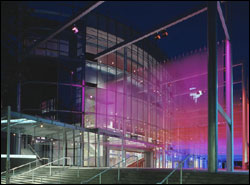TO BEGIN WITH: The sound appears to be great. Even all the way down front on far stage left, where sounds from the stage and from the pit seemed barely to occupy the same space, . . . even in that spot the sound wasn’t bad. And people placed more advantageously thought the sound fine and the mix satisfactory. So the new $130 million Marion Oliver McCaw Hall sounds good.
It makes what’s on its stage look good, too. Thanks to far better lighting- instrument placement than the old Opera House could afford, crowded stage pictures in Pacific Northwest Ballet stagings like Symphony in Cwhich in the past always appeared flat and confusinggained in dimension and clarity. No question, the city’s acousticians and engineers have done a fine job. Hold that thought through what follows.
WHAT THE techies couldn’t do was make Saturday’s grand-opening celebration sizzle. Seattleites at least those Seattleites who can be bullied into evening-dress and black tie on a hot summer-weekend eveningaren’t known for partying with gusto. And our periodic bouts of civic self- congratulation always ring particularly false, deprived of resonance by our perennial, though always tacit, lack of civic self-confidence.
Case in point: The video segments sprinkled through the “entertainment” portion of the evening provided an opportunity for money people to slather art people with vacuous, fulsome, unfelt praise. It would have played better to a full house, not one in which the second balcony was all but utterly empty; not a house where many attendees were given last-minute free tickets to mask the paucity of takers at the $300 to $500 list price; not a house still seeking contributions to cover a quarter of its price tag. A number of opening-night actsJane Eaglen belting out Elizabeth’s salute to the hall of song from Wagner’s Tannh䵳er, Vinson Cole’s sauve rendition of Gluck’s setting of Orpheus’ lament for Eurydiceevoked something resembling an ovation, but most of the time the applause barely lasted until the curtain fell.
And what a curtain. There are certainly arguments for replacing the traditional opera-house red-velvet drop curtain with something more stylish and contemporarily elegant. But sprinkling it with glitter doesn’t fill that order. There’s something sluttish about this curtain: a touch of downmarket Vegas. The long featureless corridors leading from the lower lobby to the front of the orchestra level are not just painted but illuminated in lurid brothel red. Access to the higher reaches of the box seats is adorned with strings of red accent bulbs reminiscent of suburban Christmas lighting.
After the impact of sheer redness fades, your eyes notice other tints, though you’ll have to squint against hundreds of overbright mini-spotlights to do it. Seating is upholstered in soft sage green. The boxes themselves are painted dull bronze, the walls a dusty plum color, while the recesses of the ceiling are deep blue with vague swirls of black. None of the colors used, apart from that red, are offensive in themselves, but they don’t particularly go together, either.
Nor do they go with the lobby, which looks like it was designed by another firm entirely. No fusty, dusty colors here: The overall look is deco moderne, as chilly and austere as the interior of a Sub-Zero refrigerator. Multistory windows admit the light we so longed for in the old Opera House lobby, but beyond lightand considerable sunset glarethat’s all they do: The view is restricted to the quasi-mansard side windows of PNB’s Phelps Center next door. From the first-floor gallery, they strangely resemble a multiunit condo development that’s crept up to peek at us.
MOST PUZZLING of all is the entry courtyard. Hanging over it are immense spans of what appears to be chain-link fencing, giving the effect of a multilayered bug zapper. Even at first glance the heart sinks, suspecting that relentless bane on our cityscape, Public Art, and so it proves to be. After dark, the penitentiary wirework is to be illuminated by Leni Schwendinger’s lasers, in a sort of Mercer Street-level version of the northern lights. Just watch your footing while gazing up at the light show if you want to avoid soaking your evening pumps in the plaza’s “water feature”: barely sloping, 80 feet long, 15 feet wide, and one-eighth inch deep. It’s only a matter of time until someone slips and falls, till the lawsuits begin, till the “Caution Wet Pavement” cones are brought out while the case is pending.
But regardless of the bug zappers outside and the bordello-hued interior, hang on to this final thought: The sound is great.








